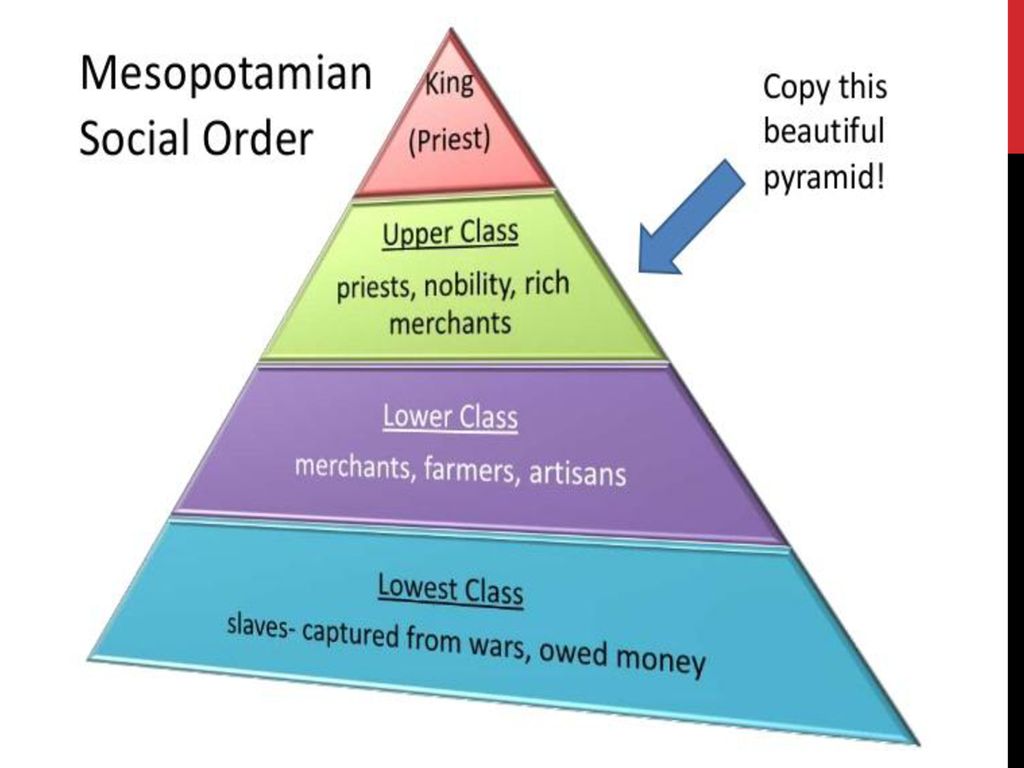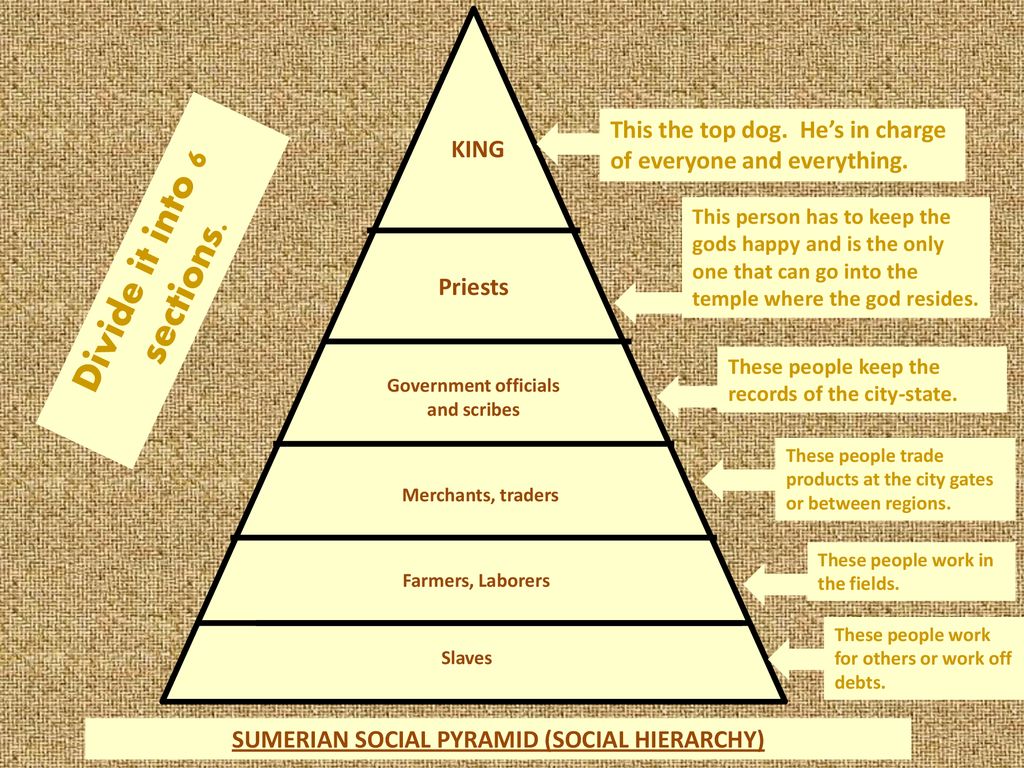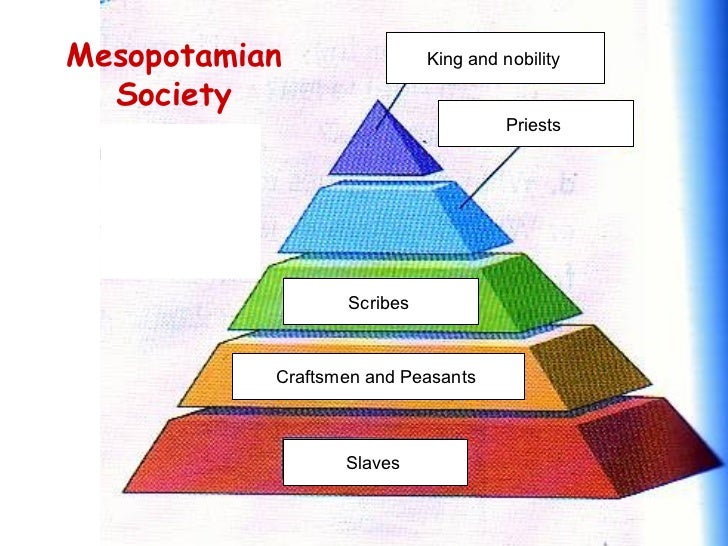Unveiling Mesopotamia: Social Pyramid Explained [Discover Now!]
How did the earliest civilizations, like those in ancient Mesopotamia, organize their societies, and what can we learn from their structures? Mesopotamia, the "cradle of civilization," offers a compelling case study in social stratification, power dynamics, and the enduring impact of economic factors on social status.
Ancient Mesopotamia, a region nestled between the Tigris and Euphrates rivers, witnessed the birth of some of the earliest known complex societies. This fertile land, present-day Iraq, was home to the Sumerians, Akkadians, Babylonians, and Assyrians, each contributing to a rich tapestry of cultural, technological, and societal advancements. These civilizations, flourishing from approximately 4500 BCE to 539 BCE, were not monolithic. Instead, they were characterized by intricate social structures that dictated the lives, opportunities, and limitations of their inhabitants. A deep dive into these structures reveals not only the organization of ancient life but also provides valuable insights into the origins of social hierarchy and inequality that continue to resonate today. Studying the social classes of ancient Mesopotamia offers valuable knowledge and insights into the roots of social hierarchy and inequality in human civilization.
| Category | Details |
|---|---|
| Overview | Ancient Mesopotamian society was characterized by a hierarchical structure, often visualized as a pyramid. This structure dictated social roles, influenced economic organization, and impacted the stability of the civilization. The social structure was crucial for governance, economic organization, and social stability. |
| Time Period | From approximately 4500 BCE to 539 BCE, encompassing various civilizations in the region. |
| Geographical Location | Mesopotamia, located in present-day Iraq, between the Tigris and Euphrates rivers. |
| Key Civilizations | Sumerians, Akkadians, Babylonians, and Assyrians. |
| Social Classes |
|
| Basis of Hierarchy | Primarily based on wealth, power, and occupation. |
| Role of the King | Held significant power, responsible for creating laws, and often considered a divine ruler. |
| Sources of Slavery | Debt, being sold by family members, punishment for crimes, or being kidnapped. |
| Economic Influence | Economic power heavily influenced social status; access to resources, trade, and control of land were key factors. The artificial irrigation system led to social stratification and the formation of different communities. |
| Architectural Reflection | Construction of monumental structures like ziggurats (from 4200 to 2500 years ago) reflected societal organization and power dynamics. |
| Impact on Subsequent Societies | The Mesopotamian social pyramid served as a model, influencing the development of social hierarchies in subsequent cultures. |
| Primary Source | Britannica - Mesopotamia |
At the apex of this social pyramid stood the king. The king, often seen as a divine ruler or a representative of the gods, possessed supreme authority. He controlled the land, the military, and the legal system. The king was responsible for creating the laws. Beneath the king, the nobility and priests formed the upper echelon. Nobles, often related to the king, held significant land and political power, while priests managed religious affairs, controlled temples, and wielded considerable influence over daily life. The king, nobility, and the priests who stood on the top of the social pyramid.
- Red Black Bathroom Ideas Bold Designs Inspiration
- Mark Harmons Political Journey From Ncis To Tennessee Politics
The middle class encompassed a diverse group of individuals. Scribes, essential for record-keeping and administration, were highly respected. Merchants and artisans, who facilitated trade and crafted goods, enjoyed a relatively comfortable life. The middle class, the second most important section of the pyramid, included merchants, craftspeople, artisans, and metal workers. Their skills and services were in demand, allowing them to accumulate wealth and social standing. They were responsible for building the ziggurats, and crafting new farming tools.
The lower class constituted the majority of the population. This group included farmers, laborers, and servants who toiled to produce food and maintain the infrastructure of society. They lived a life of hard work and were largely dependent on the upper classes. The lower class comprised of farmers, laborers, and servants; and enslaved individuals who formed the
At the very bottom of the social pyramid were the slaves. Slavery was a harsh reality in ancient Mesopotamia. People could become enslaved in several ways: selling themselves into slavery to pay off a debt, being sold by a family member to relieve debt, being sold as punishment for crime, or being kidnapped and sold into slavery in another region. Slaves, often prisoners of war or those unable to repay debts, were considered property and had very few rights. Their lives were completely at the mercy of their owners. The slaves were the lowest in the mesopotamia social structure pyramid. The social class pyramid in mesopotamia was characterized by a distinctive hierarchy.
- Access Your Raspberry Pi Remotely Free Guide Setup Tips
- Tamilblastersrodeo What You Need To Know Safe Alternatives
The social hierarchy wasn't just a theoretical construct; it manifested in various aspects of life. Social class determined one's lot and reflected the daily life, habits, and appearance of an individual. The houses people lived in, the clothes they wore, the food they ate, and the jobs they held were all determined by their social standing. Those at the top enjoyed luxurious lifestyles, while those at the bottom struggled for survival. By studying the social classes of ancient mesopotamia, we can gain valuable knowledge and insights into the roots of social hierarchy and inequality in human civilization. This structure was crucial for governance, economic organization, and social stability. The hierarchy of mesopotamia can be symbolized as a triangle shaped pyramid. The social class pyramid of mesopotamia is a fascinating subject that provides insight into the ancient civilization's complex societal structure.
Economic power played a crucial role in shaping social status. Access to resources, control of trade, and land ownership were all key determinants. Merchants and artisans, through their skills and trade, could accumulate wealth and improve their standing, while farmers and laborers, dependent on the land and often burdened by debt, faced significant challenges. The construction of ziggurats was common from 4200 to 2500 years ago. These impressive structures, serving religious and administrative purposes, also symbolized the power and organization of the ruling elite. Mesopotamian social structure consisted of:
The social pyramid of mesopotamia is the graphic representation that shows how the society during the ancient ages, in the near east and, more specifically, in the civilizations that developed on the banks of the tigris and euphrates rivers. In this section of our website, we invite you to step into the world of mesopotamian society and culture, where each article unveils a different aspect of the ancient. The artificial irrigation system led to social stratification and the formation of different communities. The mesopotamia social hierarchy basically consisted of three classes such as nobility, free citizens and slaves. The social pyramid of ancient mesopotamia consisted of several distinct layers, each representing different social classes and their corresponding roles. Understanding the classes and social structure of mesopotamian society provides insights into the dynamics and values of this ancient civilization. Ancient mesopotamia was organized by their status using a social structure pyramid.
The mesopotamian social pyramid was a crucial aspect of ancient civilization, defining the roles and relationships within society. This hierarchical structure allowed for the organization of labor, governance, and social interactions that formed the backbone of mesopotamian life. It created a baseline for different cultures to adapt as their social hierarchies developed. If taken in a broader sense, the top of the pyramid consisted of the king and his family, the nobles and their families, the priests and the military leaders. Learn about ancient mesopotamia's social structure and class system from the ancient world. The mesopotamia social hierarchy basically consisted of three classes such as nobility, free citizens and slaves. The social structure of mesopotamian society was hierarchically organized, with distinct classes that determined individuals roles and status within the community. The social class pyramid in mesopotamia was characterized by a distinctive hierarchy. The social pyramid of mesopotamia is the graphic representation that shows how the society during the ancient ages, in the near east and, more specifically, in the civilizations that developed on the banks of the tigris and euphrates rivers. It was organized based on people's wealth. There were four sections of the pyramid. First and most important was their priest or king. The king was the top rank holder of the mesopotamia social hierarchy. The king was responsible for creating the laws.
The legacy of Mesopotamia extends far beyond its geographical boundaries. Its social structure, though unique to its time, provided a foundation for subsequent civilizations. The concept of social hierarchy, the significance of economic power, and the influence of religious and political authority all have roots in the ancient Mesopotamian experience. By studying their social classes, we can see how each level of a civilization was classified, and back when they were a full functioning civilization, they had classifications for people. The social class pyramid of mesopotamia is a fascinating subject that provides insight into the ancient civilization's complex societal structure. The slaves were the lowest in the mesopotamia social structure pyramid. Learn vocabulary, terms, and more with flashcards, games, and other study tools. The hierarchy was generally divided into three primary classes: The upper class, the middle class, and the lower class, with slaves at the bottom. By studying the social classes of ancient mesopotamia, we can gain valuable knowledge and insights into the roots of social hierarchy and inequality in human civilization. This stability reflects on the level of social class.
The structured classes laid the groundwork for future societies. Explore the intricate social hierarchy of ancient sumer, the first major civilization in mesopotamia. Ancient mesopotamia social class determined ones lot and reflected the daily life, habits, and appearance of an individual. The mesopotamia social pyramid was the basis for other societies to follow.



Detail Author:
- Name : Maribel Rosenbaum
- Username : lwhite
- Email : lynch.makenzie@bogan.com
- Birthdate : 1987-01-13
- Address : 6258 Rolfson Streets West Gladyce, LA 70491-7681
- Phone : (360) 230-6849
- Company : Ernser Group
- Job : Watch Repairer
- Bio : Distinctio voluptatem ullam ad adipisci tempora et. Magnam sit eum accusamus eaque qui. Et accusamus eveniet delectus ad dicta. Sed esse laborum fugit animi.
Socials
instagram:
- url : https://instagram.com/ambroseleffler
- username : ambroseleffler
- bio : Non tempore quisquam eos iusto et. Eos dolorem illo dolorum sed unde.
- followers : 5298
- following : 2549
facebook:
- url : https://facebook.com/aleffler
- username : aleffler
- bio : Sed eum ea voluptates est sunt voluptas.
- followers : 5477
- following : 77
twitter:
- url : https://twitter.com/ambrose6553
- username : ambrose6553
- bio : Nihil ut alias a ut sunt. Pariatur nulla quod eos hic aut. Quis aut autem delectus tempore fugit repellat. Molestias cupiditate expedita beatae sit omnis est.
- followers : 3254
- following : 1390